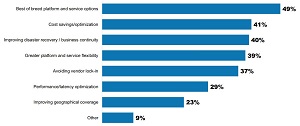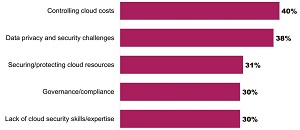News
Study Shows Upside, Downside of Using Multiple Clouds
Research firm IDG's new study on cloud computing reaffirms the cloud is the place to be for enterprises by documenting pervasive adoption trends, but it also shows both the upsides and downsides of some aspects, such as using multiple public clouds.
The 2020 IDG Cloud Computing Survey is out for the eighth year, conducted to measure cloud computing trends among technology decision-makers ( ITDMs), including usage and plans across multiple cloud services, investments, business drivers, and shifting services and applications to the cloud. Those usage metrics and plans all pretty much go up, with findings such as:
- Cloud adoption levels that have held steady since 2015 have accelerated in the last two years
- In 2020, 81 percent of survey respondents reported already using computing infrastructure or having applications in the cloud, compared to 73 percent in 2018
- Another 12 percent plan to adopt cloud-based applications in the next 12 months, and 6 percent plan to do so in the next 1 to 3 years
- Cloud adoption has also reached more than two-thirds in every industry
However, enterprises are often just as interested in problems and challenges experienced in the seismic shift to the cloud, and the study in particular documents those within the scope of multicloud implementations. More than half of the survey's respondents currently use multiple public clouds, with IT departments driving such usage in pursuit of goals such as utilizing best-of-breed platform and service options, achieving cost savings/optimization and improving disaster recovery/business continuity.
 [Click on image for larger view.] Best-of-Breed & Service Options Top Multicloud Goals (source: IDG).
[Click on image for larger view.] Best-of-Breed & Service Options Top Multicloud Goals (source: IDG).
To those ends, ITDMs report benefits of multiple cloud implementations aligning with the aforementioned goals, such as:
- Greater platform and service flexibility (43 percent)
- Improving disaster recovery/business continuity (41 percent)
- Having best-of-breed platform and service options (41 percent)
"To reap the full benefits of multiple public clouds, and ensure integrations and costs are actively monitored, organizations utilize cloud management tools," IDG said. "Close to two-thirds (64 percent) say they use the native management tools for each of their public cloud platform. When asked about the key deciding factors behind which multi-cloud management tool to implement, ITDMs rank cost management, reporting and optimization; performance monitoring and management; and security, governance and policy compliance at the top."
However, not all multicloud implementations come with silver linings. IDG said, that despite the aforementioned benefits reported by users of multiple public clouds, 79 percent of organizations have experienced some downside to using multiple public clouds.
These include:
- Data privacy and security (40 percent)
- Controlling cloud costs (37 percent)
- Lack of cloud management skills/expertise (34 percent)
"Using more clouds apparently makes the need for expertise in managing them more pressing, as this issue was a distant seventh place among respondents not using multiple public clouds," IDG said.
 [Click on image for larger view.] Top 5 Challenges to Public Cloud (source: IDG).
[Click on image for larger view.] Top 5 Challenges to Public Cloud (source: IDG).
On average, ITDMs identify five primary challenges experienced with the use of public clouds in general (not specifically multicloud implementations):
- Controlling cloud costs
- Data privacy and security challenges
- Securing/protecting cloud resources
- Governance/compliance
- Lack of cloud security skills/expertise
"Gone are the days where IT managers get pushback for opting to deploy workloads in the cloud versus their own private data center," said Eric Knorr, editor in chief, IDG Communications, Inc. "With its agility and scalability, especially during a time where cloud-based collaboration tools are essential for a successful remote work environment, cloud computing is showing a strong adoption curve. However, companies are also learning that their migrated applications need to be appropriately managed and optimized in order to meet their full expectations; hence the need for multi-cloud management tools and cloud specific roles."
Other highlights of the survey include:
- 32 percent of total IT budgets will be allocated to cloud computing within the next year
- Current cloud-based applications were: purpose-built for the cloud (46 percent); moved from on-premises environments (54 percent)
- 35 percent of respondents say their organization's use of multiple public clouds was an IT department suggestion
The study of 551 ITDMs (involved in the purchase process for cloud computing and whose organization has, or plans to have, at least one application or a portion of their infrastructure in the cloud) was fielded March 9, 2020, through April 13, 2020.
About the Author
David Ramel is an editor and writer at Converge 360.